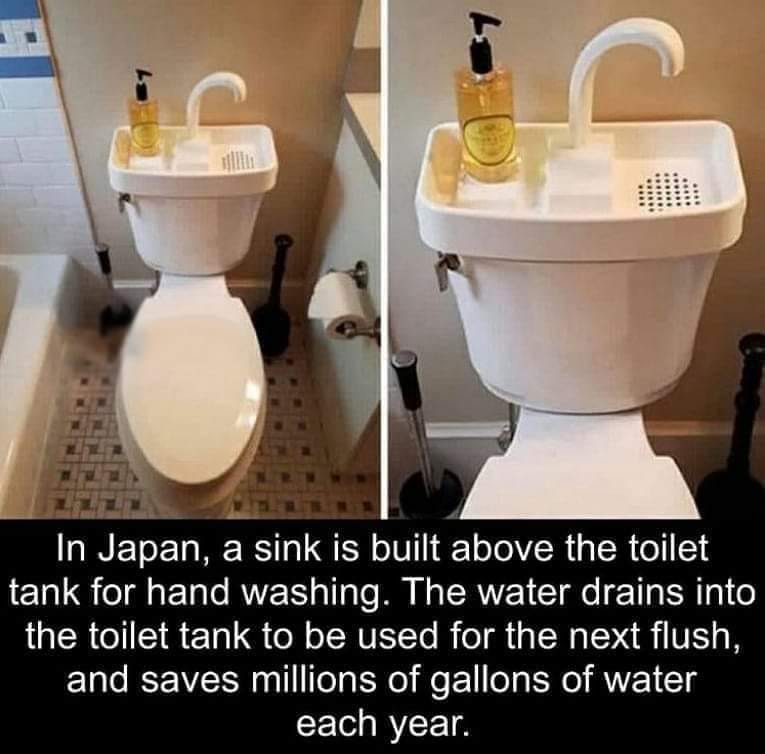Have you ever stumbled upon a sink perched right above a toilet and thought, “What’s the point of that?” In Japan, this ingenious setup isn’t just a quirky design choice—it’s a shining example of the country’s commitment to sustainability and efficiency. This system is not only practical but also eco-friendly, making it a model for the rest of the world to follow. Let’s dive into how this innovative design works, why Japan embraced it, and how it could revolutionize bathrooms worldwide.

How Does the Sink-Over-Toilet System Work?
At first glance, the design might seem unconventional, but its brilliance lies in its simplicity. The system uses water twice, cutting down on waste without compromising hygiene. Here’s how it operates:
When you flush the toilet, clean water flows into a small sink mounted directly above the toilet tank. You use this water to wash your hands, and instead of draining away, the used water flows directly into the toilet tank, where it’s stored for the next flush. This seamless integration of two functions—handwashing and flushing—turns everyday actions into a highly efficient process.
Why Did Japan Adopt This Design?
Japan’s adoption of the sink-over-toilet system goes far beyond convenience. It’s rooted in practical, cultural, and environmental considerations that reflect the country’s values and priorities.
-
- Water Conservation
Japan is known for its deep respect for natural resources, and water conservation is a top priority. This system significantly reduces water waste by reusing handwashing water for flushing. Given the number of times a toilet is used in a single day, the savings can add up quickly, with households conserving thousands of gallons of water each year.
- Water Conservation
- Space Optimization
In Japan’s densely populated urban areas, where space is at a premium, every square inch counts. By combining the sink and toilet into one compact unit, this design maximizes functionality while saving space. It’s particularly beneficial in small apartments and homes where a separate sink might not fit comfortably. - Encouraging Sustainable Habits
This system doesn’t just save water—it also serves as a daily reminder of the importance of resourcefulness. Every time someone washes their hands, they’re participating in a small act of sustainability, reinforcing mindful habits over time.
The Benefits of the Sink-Over-Toilet Design
This clever design offers numerous advantages that make it a standout innovation:
- Lower Water Bills: By reusing water for flushing, households can cut down significantly on water expenses. It’s an easy and effective way to save money while reducing environmental impact.
- Hygiene Without Compromise: Despite reusing water, the system maintains impeccable hygiene. The water used for handwashing is clean and does not come into contact with the toilet’s contents.
- Ideal for Compact Spaces: In urban settings or tiny homes, the sink-over-toilet design eliminates the need for a separate sink, making it perfect for maximizing functionality in limited spaces.
Cultural Values Reflected in the Design
Japan’s sink-over-toilet innovation is more than just a practical solution; it’s a reflection of the country’s cultural principles.
The concept of mottainai—a Japanese term that embodies the idea of reducing waste and maximizing resource use—is perfectly illustrated by this system. It’s a small but powerful example of how thoughtful design can align with values like respect for nature and resourcefulness.
Moreover, Japan’s reputation for meticulous attention to detail and innovation shines through. Whether it’s high-tech toilets or energy-efficient appliances, the country continues to set the standard for functional, eco-friendly solutions.
Could This Design Work Globally?
Absolutely. The sink-above-toilet concept has enormous potential to address pressing challenges worldwide.
- Water Scarcity: In regions where water is a scarce resource, this system could be a game-changer. By reducing water consumption, communities could preserve their limited supplies for essential needs like drinking and agriculture.
- Cost-Effectiveness: Lower water usage means reduced utility bills, making this design an appealing choice for households and businesses alike.
- Space-Saving in Urban Areas: As urbanization increases, space is becoming a premium everywhere. This compact system is ideal for small apartments, public restrooms, and office facilities.
How to Bring This Innovation into Your Home
Inspired by Japan’s ingenuity? Here’s how you can adopt this design:
- Purchase a Pre-Made Unit: Many plumbing supply stores now offer sink-over-toilet fixtures designed for easy installation.
- Retrofit Your Existing Toilet: If you can’t find a ready-made option, consult a plumber to customize your current setup.
- Embrace Minimalism: Consider this as part of a broader shift toward minimalist and eco-friendly living. Small changes like this can significantly reduce your environmental footprint.
Beyond the Sink: Japan’s Leadership in Sustainability
The sink-over-toilet design is just one example of Japan’s commitment to sustainability. The country is also a pioneer in other areas, from toilets with water-saving features to public spaces equipped with sensor-activated faucets and hand dryers. These innovations demonstrate how thoughtful design can create a culture of mindfulness and eco-conscious living.
Conclusion: A Simple Idea with a Big Impact
Japan’s sink-over-toilet system proves that small changes can lead to significant results. By reusing water and optimizing space, this design embodies the principles of sustainability, efficiency, and mindfulness. It’s not just a quirky bathroom feature—it’s a lesson in how innovation can create a more sustainable future.
So, next time you wash your hands, think about where that water could go next. Could it serve a second purpose? With inspiration from Japan, the answer might just be yes.





